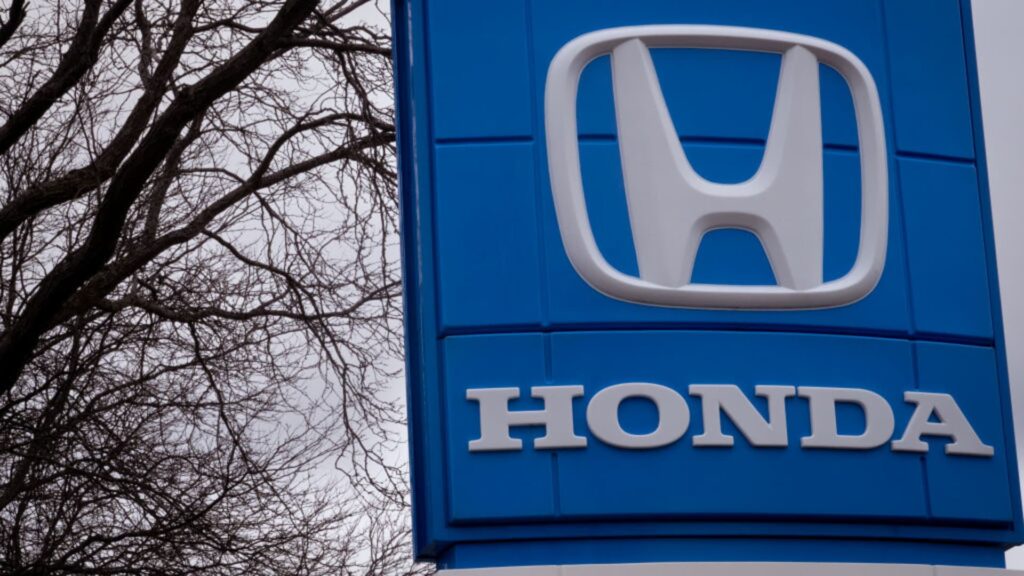A sign marks the location of a Honda dealership in Libertyville, Illinois, on Dec. 18, 2024.
Scott Olson | Getty Images
Japanese auto giant Honda‘s first-quarter operating profits fell 50% year over year on Wednesday, missing estimates due to U.S. auto tariffs and a stronger yen.
Here are Honda’s results compared with the mean estimates from LSEG:
Revenue: 5.34 trillion yen ($36 billion) vs. 5.25 trillion yenOperating profit: 244.17 billion yen vs. 323.48 billion yen
In the first quarter of its fiscal year ending on March 31, 2026, Honda’s revenue came in at 5.34 trillion yen, beating mean estimates from LSEG.
Operating profit fell about 50% to 244.17 billion yen, missing LSEG’s mean estimates of 323.48 billion yen.
However, Japan’s second-biggest carmaker said that the impact of the auto tariffs would be smaller than previously expected.
The company also forecast the yen to weaken further, as it raised its full-year operating profit forecast by 200 billion yen, or 40%, to 700 billion yen compared to its previous forecast of 500 billion yen.
A Honda executive said in an earnings call that the impact of tariffs would be mitigated by Honda’s manufacturing plants in the U.S.
“Our local production manufacturing ratio is high to begin with… our stance is to produce where there is demand,” he said, adding that the company would look for ways to increase production volume in the U.S. without spending too much on the capital investment.
The company is also considering building up production stateside for its new energy vehicles to avoid tariffs.
Shares of Honda rose 1.7% after its earnings release before paring gains.

Honda
Honda’s motorcycle business saw its sales expand in markets like Brazil and Vietnam to achieve its highest-ever quarterly operating profit. Meanwhile, it noted that its electric vehicle sales remained strong in North America.
The U.S. accounted for around a quarter of Honda’s exports from Japan in the first half of the year. Its global sales fell 5% over the period, impacted by declines in China, Asia and Europe.
Auto exports to the U.S. are a cornerstone of Japan’s economy, making up 28.3% of all shipments in 2024, Japan’s customs data showed.
Japan’s carmakers have been doubling down on price cuts to retain market share in the U.S. after President Donald Trump’s 25% tariffs on imported vehicles, which came into effect on April 3.
Trump announced a new trade deal with Japan on July 22 that is said to include a lower tariff rate of 15% on Japan-made vehicle imports to the U.S. However, the timeframe for the change to take effect was not clarified.
In June, the value of Tokyo’s car exports to the U.S. fell 25.3% year over year, even though car export volumes to the U.S. rose by 4.6% in the same period, according to data from Japan’s trade ministry.
Tariffs hit Japan’s auto giants
Other Japanese car makers have also been suffering from trade headwinds. On July 30, Japan’s Nissan reported a net loss of 115.8 billion yen for the first quarter, attributing adverse exchange rate movements and the impact of U.S. tariffs.
Toyota, Japan’s largest carmaker, is set to report earnings on Thursday, with economists polled by Reuters expecting that it will post its lowest operating profit in over two years. That comes despite the company reporting that its worldwide sales reached record highs in the first six months of the year.
Back in February, Honda and Nissan terminated talks over a $60 billion merger, which would have created the world’s third-largest automaker by sales volume. In the earnings call, a Honda executive said the companies were still exploring a business-related collaboration, but didn’t have anything to announce.
Japanese Prime Minister Shigeru Ishiba said Monday he would not hesitate to speak with President Donald Trump to ensure the cut to U.S. automobile tariffs is implemented soon.
The country’s chief trade negotiator Ryosei Akazawa left for Washington on Tuesday, seeking to press Trump to sign an executive order that would confirm the exact date for the auto tariffs to be lowered.

